|
Forums46
Topics551,832
Posts9,897,181
Members88,155
| |
Most Online28,231
Feb 7th, 2025
|
|
|
 Re: Deer Management
[Re: AmoCuernos]
#2648447
10/10/11 09:29 PM Re: Deer Management
[Re: AmoCuernos]
#2648447
10/10/11 09:29 PM
|
Joined: Aug 2009
Posts: 11,124
LandPirate

THF Celebrity
|

THF Celebrity
Joined: Aug 2009
Posts: 11,124 |
I can't imagine being able to eliminate the crab claws in that area. I hunted 100,000 acres NW of Angelo for years and there was a huge percentage of the bucks had 'em.
The ranch I hunted had never, ever, in it's entire history, been leased for hunting. We only got to hunt because my uncle was the foreman of the ranch. The deer herd was as close to pure as it could possibly be. I think that crab claws are just a trait of that area. I'm betting that every deer out there carries a gene for crab claws. Just my opinion.
Mike
Buda, Tx
Hunt near Freer
|
|
|
 Re: Deer Management
[Re: LandPirate]
#2648520
10/10/11 09:56 PM Re: Deer Management
[Re: LandPirate]
#2648520
10/10/11 09:56 PM
|
Joined: Oct 2007
Posts: 5,235
highlonesome1

THF Trophy Hunter
|

THF Trophy Hunter
Joined: Oct 2007
Posts: 5,235 |
Txhunter I am familiar with your area and it sounds like you are doing just fine. Going off your posts pics etc, your deer are fine as any in the area. Crab claw is common on our place in Schleicher County as well. Keep in mind that trophy bucks are not always dominant bucks.
This year I would thin the herd by taking as many 4-5+ year old deer as you can. That is what I plan on doing. There is only so much browse for so many deer and with the drought possibly continuing through next year, this may be the best thing to do long term.
While I tell myself that alfalfa / protein makes all the difference, mother nature can provide way more than I can with just a couple good rains. If your deer are comparable to deer in their natural environment, you are doing the best you can.
|
|
|
 Re: Deer Management
[Re: highlonesome1]
#2648858
10/10/11 11:38 PM Re: Deer Management
[Re: highlonesome1]
#2648858
10/10/11 11:38 PM
|
Joined: Aug 2010
Posts: 60,296
stxranchman

Obie Juan Kenobi
|

Obie Juan Kenobi
Joined: Aug 2010
Posts: 60,296 |
Have you done a survey every year? Do you do incidental counts? Keep harvest record on every deer taken? Do you have the past data to look at to see what the trends have been? Are buck/doe weights higher, the same or lower by age class? If you are not doing these things listed then you are just hunting at this point and not following a mangement plan or goal. Ever deer you shoot from the herd is culled from the herd be it a trophy or a doe. You can call it what you want but is the same result. It is a management descision and a number on the harvest data sheet. It is all very important data that you can show you what is going on with your herd.
I am also sure I know this ranch he is hunting on and what it has produced in the past as far as top end type deer. So genetics are not an issue if it is the same ranch.
Are idiots multiplying faster than normal people? ![[Linked Image]](http://neoswarm.com/images/Bug_Crawling.gif)
|
|
|
 Re: Deer Management
[Re: stxranchman]
#2649085
10/11/11 12:18 AM Re: Deer Management
[Re: stxranchman]
#2649085
10/11/11 12:18 AM
|
Joined: Apr 2011
Posts: 29,138
Western

THF Celebrity
|

THF Celebrity
Joined: Apr 2011
Posts: 29,138 |
You also don't have a clue what does carry the traits you like/dislike either
If at first you dont succeed, then skydiving is not for you..
"Don't trust everything you read on the Internet"- Abraham Lincoln
Dennis
|
|
|
 Re: Deer Management
[Re: AmoCuernos]
#2649189
10/11/11 12:42 AM Re: Deer Management
[Re: AmoCuernos]
#2649189
10/11/11 12:42 AM
|
Joined: Sep 2010
Posts: 35,954
txshntr
 OP
OP
T-Rex Arms
|
OP

T-Rex Arms
Joined: Sep 2010
Posts: 35,954 |
Shooting culls in a wild setting (low fence or high fence with no hands on) does nothing to impact the genetics enough in a deer herd for a human to see it in their lifetime.
So it is by chance or nature that we see less crab clawed 8's on our place now than we saw 10-15 years ago and the garage full of antlers with this trait didn't have anything to do with it?  Do you have the same number if deer? Could it be that 15 years ago you were new to select this trait as inferior, so you were shooting them out of every age class and now you pretty much just shooting them out of the younger age class 1 year at a time? Have you improves nutrition at all with your management plan? Are you having less fawns born every year because you have lowered doe numbers? If you have fewer buck fawns being born because you have less does.... You could still be shooting the same % of crabbies out of the population... There might just be fewer bucks... That is a good point... Will have to think about it
|
|
|
 Re: Deer Management
[Re: Western]
#2649203
10/11/11 12:43 AM Re: Deer Management
[Re: Western]
#2649203
10/11/11 12:43 AM
|
Joined: Sep 2010
Posts: 35,954
txshntr
 OP
OP
T-Rex Arms
|
OP

T-Rex Arms
Joined: Sep 2010
Posts: 35,954 |
You also don't have a clue what does carry the traits you like/dislike either True. Have to hope for the best
|
|
|
 Re: Deer Management
[Re: txshntr]
#2649304
10/11/11 12:59 AM Re: Deer Management
[Re: txshntr]
#2649304
10/11/11 12:59 AM
|
Joined: Jan 2007
Posts: 3,410
Tye

Veteran Tracker
|

Veteran Tracker
Joined: Jan 2007
Posts: 3,410 |
Do y'all cull out bucks with less than 10 points and have a crab claw as a g4? Or are you talking out 8s only? Crab claws are a gene in my herd as well. Some times we get main beams that almost touch in the middle. Here is a crab claw 9. Does he get another year in your program? 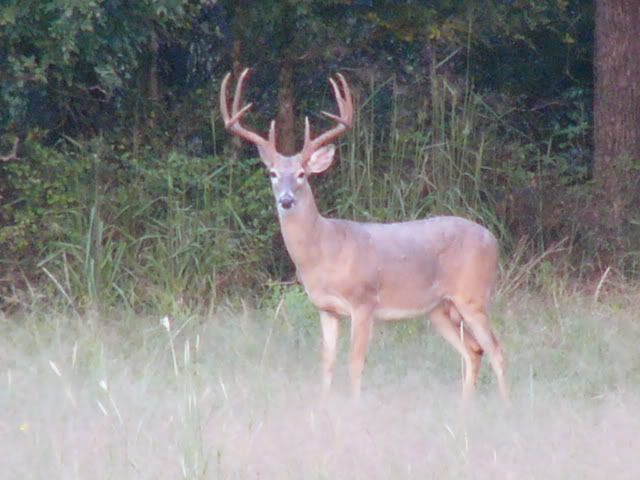
If you shoot a young deer because a neighbor will shoot it, you are that neighbor.
|
|
|
 Re: Deer Management
[Re: Tye]
#2649340
10/11/11 01:07 AM Re: Deer Management
[Re: Tye]
#2649340
10/11/11 01:07 AM
|
Joined: Sep 2010
Posts: 35,954
txshntr
 OP
OP
T-Rex Arms
|
OP

T-Rex Arms
Joined: Sep 2010
Posts: 35,954 |
|
|
|
 Re: Deer Management
[Re: Tye]
#2649356
10/11/11 01:09 AM Re: Deer Management
[Re: Tye]
#2649356
10/11/11 01:09 AM
|
Joined: Jul 2008
Posts: 1,258
AmoCuernos

Pro Tracker
|

Pro Tracker
Joined: Jul 2008
Posts: 1,258 |
Do y'all cull out bucks with less than 10 points and have a crab claw as a g4? Or are you talking out 8s only? Crab claws are a gene in my herd as well. Some times we get main beams that almost touch in the middle. Here is a crab claw 9. Does he get another year in your program?  I love deer that look like that... Those 4's can get long really easy when the put on more beam.
|
|
|
 Re: Deer Management
[Re: txshntr]
#2649357
10/11/11 01:09 AM Re: Deer Management
[Re: txshntr]
#2649357
10/11/11 01:09 AM
|
Joined: Jan 2007
Posts: 3,410
Tye

Veteran Tracker
|

Veteran Tracker
Joined: Jan 2007
Posts: 3,410 |
What about this buck. Main frame 8 with very small G'4s with a lot of mass and some age. Sorry for the quality, its a pic of a 35mm pic? Management buck? 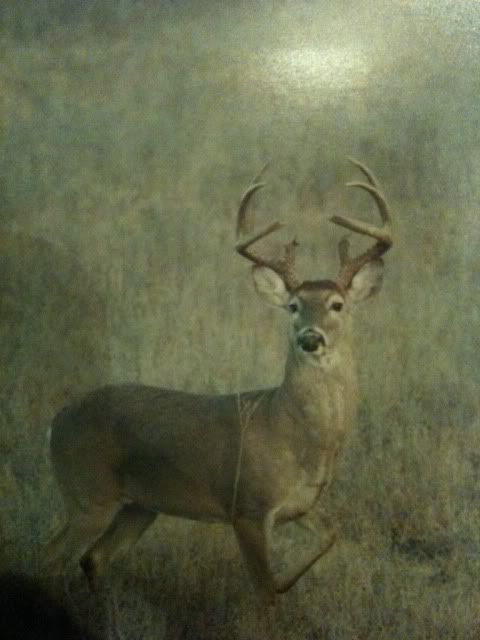
If you shoot a young deer because a neighbor will shoot it, you are that neighbor.
|
|
|
 Re: Deer Management
[Re: Tye]
#2649366
10/11/11 01:11 AM Re: Deer Management
[Re: Tye]
#2649366
10/11/11 01:11 AM
|
Joined: Sep 2010
Posts: 35,954
txshntr
 OP
OP
T-Rex Arms
|
OP

T-Rex Arms
Joined: Sep 2010
Posts: 35,954 |
3's are too long and 4's are showing. Would let him pass but a chance he would be killed
|
|
|
 Re: Deer Management
[Re: Tye]
#2649417
10/11/11 01:22 AM Re: Deer Management
[Re: Tye]
#2649417
10/11/11 01:22 AM
|
Joined: Aug 2010
Posts: 60,296
stxranchman

Obie Juan Kenobi
|

Obie Juan Kenobi
Joined: Aug 2010
Posts: 60,296 |
What about this buck. Main frame 8 with very small G'4s with a lot of mass and some age. Sorry for the quality, its a pic of a 35mm pic? Management buck?  Tye I have seen deer like this go into a 10 point with age in the Hill Country and let deer go for 2-3 yrs that looked the same like this when we killed them. It is going to depend on the individual deer and what your deer have done in the past.
Are idiots multiplying faster than normal people? ![[Linked Image]](http://neoswarm.com/images/Bug_Crawling.gif)
|
|
|
 Re: Deer Management
[Re: stxranchman]
#2649452
10/11/11 01:30 AM Re: Deer Management
[Re: stxranchman]
#2649452
10/11/11 01:30 AM
|
Joined: Sep 2010
Posts: 35,954
txshntr
 OP
OP
T-Rex Arms
|
OP

T-Rex Arms
Joined: Sep 2010
Posts: 35,954 |
Crab claws were just an example. What about 3.5 or 4.5 six and seven pointers? No brow tines? 4.5 year old eights that won't score 110"?
|
|
|
 Re: Deer Management
[Re: txshntr]
#2649468
10/11/11 01:34 AM Re: Deer Management
[Re: txshntr]
#2649468
10/11/11 01:34 AM
|
Joined: Feb 2010
Posts: 194
Switch

Woodsman
|

Woodsman
Joined: Feb 2010
Posts: 194 |
Here is an article I picked up a while back about mortality that is most intresting. You may check the credits at the bottom if they are still avaliable.
by Mickey W. Hellickson, Ph. D.
As soon as I dialed in the radio frequency to buck #0083 and picked-up the antenna, I knew the 6.5-year-old buck was dead. Instead of hearing the characteristic “beep....beep....beep” from his collar, I heard a signal that was twice as fast, “beep, beep, beep, beep.” I jumped down from the truck bed and walked in the direction where the signal was strongest. After walking only 100 yards, there he was. His tall-tined rack, with trailing skeleton, stood out like a sore thumb in the open brush country.
It was still March, only three months into my telemetry study, and already nine of the 44 bucks that we had captured the previous October had died! None of these bucks were killed by hunters, so why were they dying?
Most hunters would be surprised to learn that 10-30% of all bucks in south Texas die each year due to natural causes alone, which does not include bucks dying from hunting-related causes. Dr. Charles DeYoung, at Texas A&M University-Kingsville, was one of the first scientists to discover this alarmingly high natural mortality rate.
Dr. DeYoung and his assistants captured 282 bucks on four different ranches in south Texas from 1984-87. On two of these ranches, 53 bucks were radio collared with special, mortality-sensing transmitters that allowed the researchers to tell if the buck was dead or alive by the pulse rate of the radio signal. These bucks were monitored an average of once every 11 days from an airplane.
Whenever a buck’s radio signal indicated that he was dead, researchers walked in on foot to locate the buck and try to determine what caused the buck’s death. Twenty-three of these 53 bucks died during the study. The cause of death could not be determined for 10 of the bucks. Three bucks were killed by coyotes and two bucks were killed by mountain lions. The majority of the bucks that died on one of the ranches, died during the post-rut between late December and March.
Shortly after this study was completed, a second study was started to determine if a coyote-control program could increase buck survival during the post-rut. This study began in 1987 and lasted three years. I arrived in Texas to complete the third year of research.
Again, we captured and radio collared bucks on four different areas of two ranches. However, on two of these four areas, we did everything we could to remove as many coyotes as possible from January-June of each year. We removed an average of 107 coyotes from each of the two areas each year of the study.
We then monitored the survival of the bucks on the four areas to see if our coyote control had any benefit. Coyotes killed seven bucks. Five of these bucks were killed on the two areas of each ranch where coyotes were not controlled and removed. However, we did not see any difference in the number of bucks, or the age structure of bucks, during fall helicopter surveys. If our coyote removal was keeping bucks alive, it wasn’t increasing buck survival to the point that additional bucks were appearing in our annual helicopter surveys. The final conclusion was that buck survival did not increase enough to justify the expense related to the intensive coyote removal.
Shortly after completing this second study, I began work on a third telemetry study on one of these same two ranches toward my doctorate degree at The University of Georgia. The purpose of this additional study was to measure home range size, behaviors, and movement patterns among bucks of different ages. We captured and radio collared 125 bucks, ranging in age from 1.5-11.5 years, from 1992-94. Eleven different assistants and I used radio telemetry to track the movements of these bucks on a daily basis year-round for three years.
During the first year of my study, 11 bucks died of natural causes. During 1993, 10 bucks died of natural causes, and during 1994, eight bucks died of natural causes. Twenty-nine of the 125 bucks (23%) died of natural causes over the three years of the study.
When I looked at these data based on the mortality rates by age class, I found that young bucks and old bucks had the highest natural mortality rates. Yearling bucks (1.5 years old) had the highest natural mortality rate at 37%. The next highest natural mortality rates were found in 9.5-year-old bucks (33%), followed by 8.5 (27%) and 7.5-year-old bucks (25%). The lowest natural mortality rates were found in 4.5-year-old bucks (1%) and 5.5-year-old bucks (6%). Bucks 2.5-years-old (7%), 3.5-years-old (20%), and 6.5-years-old (8%) had intermediate mortality rates.
Amazingly, 77% (20/26) of these bucks died during the post-rut between January and March of each year, with most deaths occurring in January (11).
WHY DO SO MANY BUCKS DIE DURING THE POST-RUT?
The most accepted theory is that bucks are extremely malnourished at this time of the year due to the rigors of the rut. During the course of the rut from November through early January, bucks lose up to 30% of their body weight. They are so intent on spending every possible moment in search of does that are in “heat” that they basically quit eating in early November. By the time the rut has ended many of these bucks have lost so much weight that they cannot recover and either die of malnutrition and disease, or they are killed by coyotes.
Surprisingly, in penned deer studies, where bucks are isolated in small pens and provided unlimited, highly nutritious feed, bucks still voluntarily decrease food intake and lose weight during the rut!
Coyotes, at this same time of the year, travel in packs. Working in combination with other coyotes, they drag these worn-out bucks to the ground. Even mature bucks are susceptible to coyotes during the post-rut. Dr. DeYoung, while conducting telemetry studies on the Welder Wildlife Refuge in the 1970's, actually had coyotes kill one of his radio-collared bucks as he was tracking it!
Another theory that may explain some of the deaths was investigated by the Southeast Wildlife Disease Unit at The University of Georgia. These researchers discovered that around 10% of bucks in the Southeastern U.S. die each year from brain abscesses during the post-rut. Bucks that repeatedly fight with other bucks, as well as bucks that make high numbers of rubs during the rut, eventually rub their foreheads to the point that the skin is broken open. This break later causes an infection that allows bacteria through the skin. Once inside, these bacteria literally eat their way through the brain case of the buck. The bacteria most often tunnel through one of the fissure lines in the skull, eventually leading to the buck’s death. Unfortunately, this disease affects predominantly older-aged bucks because they often make rubs in higher numbers than younger bucks.
In order to determine if brain abscesses were causing mortality in south Texas bucks, graduate student Chris Baumann traveled from Georgia to examine as many skulls as possible from bucks that had died of natural causes. Chris examined all of the buck skulls from my study, as well as 100’s of additional Texas buck skulls but did not find a single incidence of brain abscesses. Thankfully, the researchers concluded that Texas’ warm and dry climate made it difficult for the bacteria to survive in our state.
More recently, graduate student Gabriel Karns traveled from North Carolina State University to the King Ranch to examine live bucks captured during our annual helicopter-net gun deer capture. Gabriel used cotton swabs to swab the forehead area of each captured buck. These swabs were later tested to determine if any brain abscess bacteria were present. Fortunately, Gabriel found no evidence of the bacteria from the swabs, confirming the results of Chris’ earlier study. Amazingly, 35% of Gabriel’s radio-collared bucks on Chesapeake Farms in Maryland died from brain abscesses and 62% of mortalities in bucks four years old and older were caused by brain abscesses. South Texas landowners, managers, and hunters should be thankful the bacteria cannot survive in our environment otherwise successful trophy management would be even more difficult!
WHAT DOES ALL OF THIS RESEARCH MEAN?
First, managing for mature, trophy bucks is not very efficient because many bucks will die each year of natural causes. To illustrate this, let’s start with a population of 100 six-month-old buck fawns. Our buck mortality research indicates that an average of 46% of buck fawns will die of natural causes from December-May, reducing the buck population to only 54 1.5-year-old bucks. Our data shows that an average of 37% of 1.5-year-old bucks will die of natural causes so, after the second year the buck population has decreased to only 34 2.5-year-old bucks. Our research indicates that an average of 7% of 2.5-year-old bucks die each year, knocking the population down to 32 3.5-year-old bucks. We found that 20% of 3.5-year-old bucks die of natural causes, so we are now left with 26 4.5-year-old bucks. Natural mortality in 4.5-year-old bucks is the lowest of any age class (1%) and all 26 bucks survive to age 5.5. Of the 26 5.5-year-old bucks, 6% will die before reaching age 6.5. Therefore, only 24 bucks, out of the original 100 buck fawns, will survive to age 6.5, the age at which antler growth peaks. This shockingly high rate of natural mortality means that without any hunting at all, 76 of 100 buck fawns will die before age 6.5! Ranch owners, managers, and hunters interested in managing for mature, trophy bucks need to realize that in south Texas the majority of bucks will die of natural causes before reaching maturity.
WHAT CAN BE DONE TO INCREASE BUCK SURVIVAL?
What can ranchers and managers do to increase buck survival, especially during the post-rut? Past research clearly shows that intensive coyote control methods can increase fawn survival. Therefore, as a minimum, as many coyotes as possible should be removed prior to and during the peak fawning months of June-August. However, our past research indicates that coyote control does not significantly increase survival of adult bucks, so coyote control during the post-rut probably will not help.
An additional likely solution to the high rate of natural mortality during the post-rut, is to increase the quantity and quality of the nutrition available to bucks from January-March. The nutritional level of the natural vegetation reaches a low point during late winter, further stressing bucks that are already worn out from participating in the rut. These bucks then have to suffer through late winter eating browse that is often low in nutrition. Not until spring “green-up” are these bucks able to regain the weight lost during the previous rut.
LATEST BUCK MORTALITY STUDY
More recently, graduate student Stephen Webb monitored the survival rates of 48 radio-collared bucks on the Callaghan Ranch in Webb County. This ranch provides supplemental feed on a limited basis to the deer herd. In addition, during the last two years of Stephen’s study the ranch received above-average rainfall.
Apparently, the presence of supplemental feed combined with the wet conditions greatly increased buck survival. Stephen found an average annual survival rate of 88% (only 12% mortality rate). In addition, he found that 52% of bucks radio collared as yearlings, survived to six years old. These encouraging results clearly indicate that improved nutrition, either through providing supplemental feed or increased rainfall, results in higher buck survival. Stephen and his co-investigators concluded that a large percentage of bucks can reach the mature age class under trophy management and be available for harvest.
REFERENCES
Baumann, C. D. & W. R. Davidson. 1998. An evaluation of intracranial abscesses among white-tailed deer. [Abstract] Southeast Deer Study Group 21:34.
DeYoung, C. A. 1989. Mortality of adult male white-tailed deer in south Texas. Journal of Wildlife Management 53:513-518.
Karns, G. R., R. A. Lancia, C. S. DePerno, M. C. Conner, & M. S. Stoskopf. 2009. Intracranial
abscessation as a natural mortality factor in adult male white-tailed deer. [Abstract]
Southeast Deer Study Group 32:21.
Webb, S. L., D. G. Hewitt, & M. W. Hellickson. 2007. Survival and cause-specific mortality of
mature male white-tailed deer. Journal of Wildlife Management 71:555-558.
It could be uh law I dont no. Yall have uh good un
|
|
|
 Re: Deer Management
[Re: txshntr]
#2649475
10/11/11 01:35 AM Re: Deer Management
[Re: txshntr]
#2649475
10/11/11 01:35 AM
|
Joined: Jan 2007
Posts: 3,410
Tye

Veteran Tracker
|

Veteran Tracker
Joined: Jan 2007
Posts: 3,410 |
3's are too long and 4's are showing. Would let him pass but a chance he would be killed The reason I showed these two bucks is because they are the biggest we have ever had on our ranch. Yes its HF but these are natives just to show you. The first buck(9 pointer) really blossemed the 2 years following that frame. I killed him 2 years ago and he grossed 169 and some change In 2008(on right) 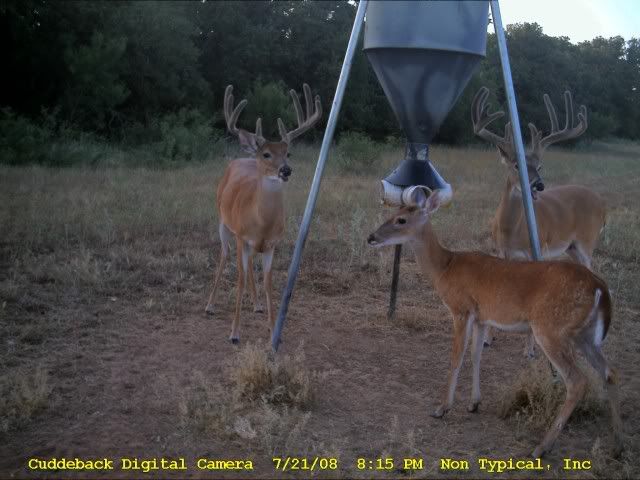 In 2009 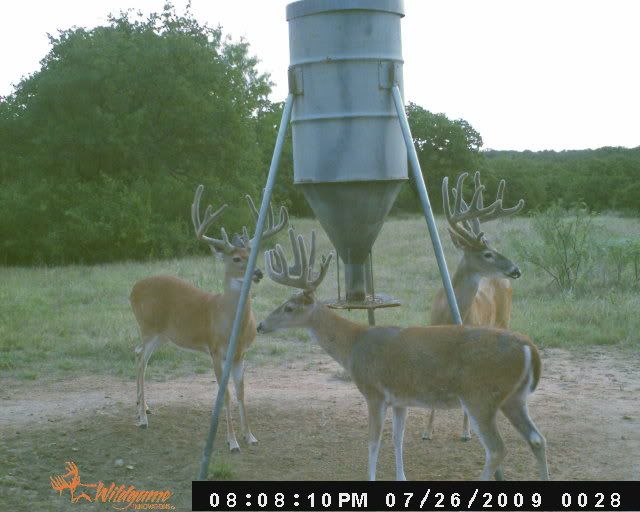 How the second buck. This one will surprise anyone. He is maybe the second largest or 3rd that we have ever had. His antlers took off the next several years and then he went down hill. around 2005 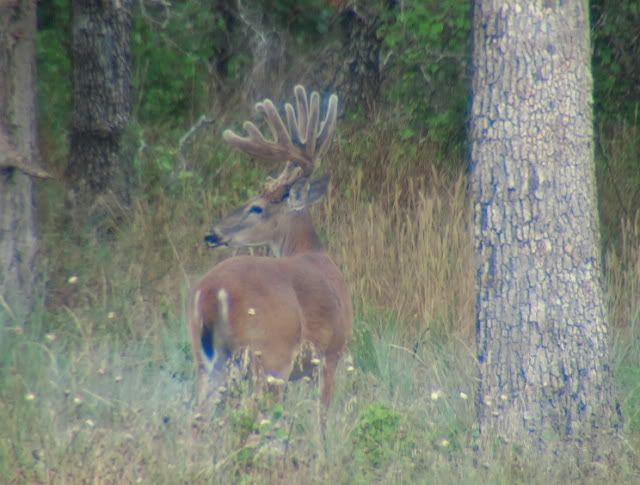 2006(buck on right) 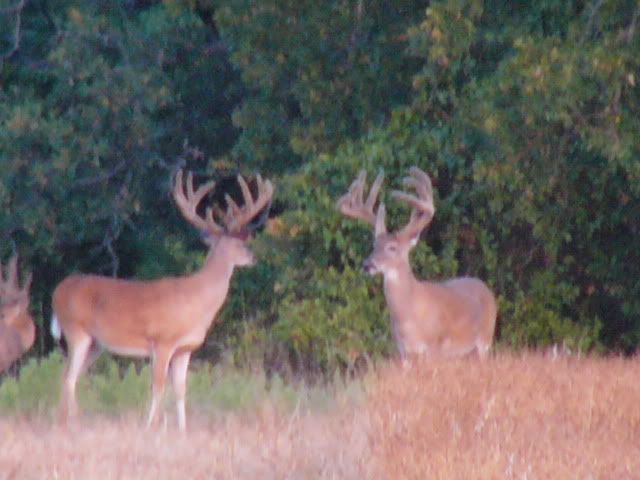 2007 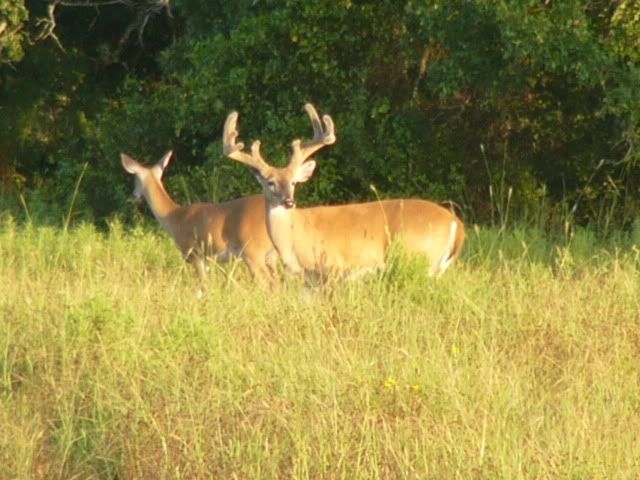 2008(buck on right) 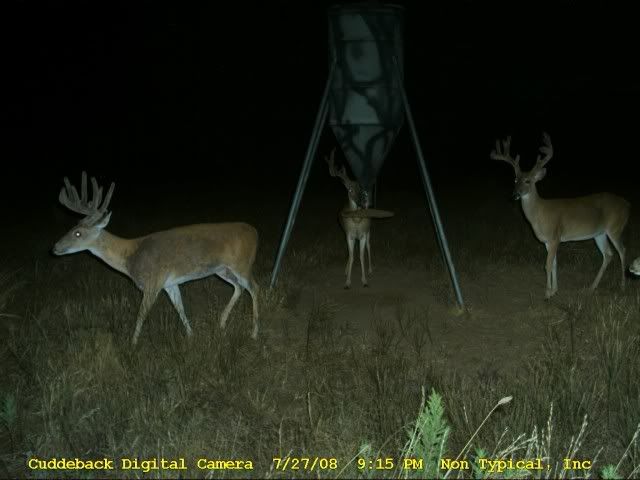 He was put on the hit list when his antlers started going down hill. He disappeared in 2007 during hunting season and he never went to protein. In 2008, he showed himself with some does(was not in a bachelor group that year). Again he was still on the list and no one ever say him after that pic was taken. My brother found him the following Spring while shed antler hunting dead of natural causes. After he blossomed in 2005, we decided to let him live until his anlters started to decline. Thought it might improve the genetics...Never really seen anything like him since. One year, we had a buck show up that was extremely wide. He came out of nowhere. He too, was going to get the pass to try and "spread" the wide gene. We found him dead as well when he was around 5.5. Haven't seen any of those type genes in any of our deer either.  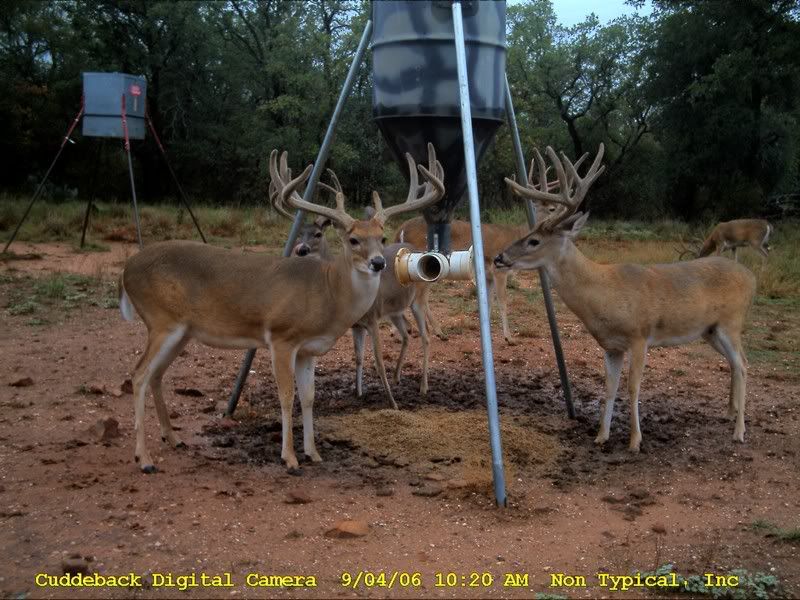 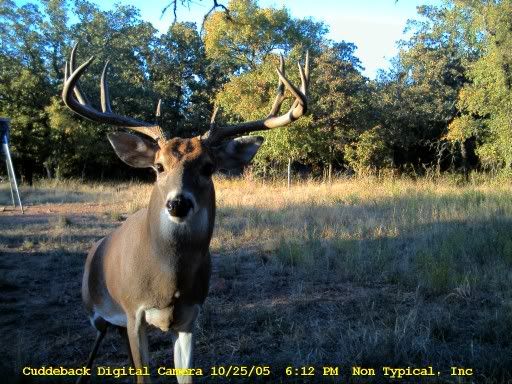
Last edited by Tye; 10/11/11 01:39 AM.
If you shoot a young deer because a neighbor will shoot it, you are that neighbor.
|
|
|
 Re: Deer Management
[Re: AmoCuernos]
#2649522
10/11/11 01:43 AM Re: Deer Management
[Re: AmoCuernos]
#2649522
10/11/11 01:43 AM
|
Joined: Feb 2010
Posts: 194
Switch

Woodsman
|

Woodsman
Joined: Feb 2010
Posts: 194 |
Some at your stage in game management opt for new blood lines. There are ranches in South Texas that do not shoot doe but captured and transported to other areas. The only charges were for capture and transportation. It is amazing how docil they are when loaded into a closed in tlr. I brought 30 back from Web county to east Texas and when I opened the door they just lay there.
It could be uh law I dont no. Yall have uh good un
|
|
|
 Re: Deer Management
[Re: txshntr]
#2649535
10/11/11 01:45 AM Re: Deer Management
[Re: txshntr]
#2649535
10/11/11 01:45 AM
|
Joined: Aug 2010
Posts: 60,296
stxranchman

Obie Juan Kenobi
|

Obie Juan Kenobi
Joined: Aug 2010
Posts: 60,296 |
Crab claws were just an example. What about 3.5 or 4.5 six and seven pointers? No brow tines? 4.5 year old eights that won't score 110"? I have never kept any deer that was 2.5 yrs or older that was less than 8 points unless I knew what the deer looked like the year before. I have never kept any buck missing any or both browtines. My minimums by age were 100 at 2.5 and 120 at 3.5 and mid 130's at 4.5 no matter how many main frame points they had. Just something I have done since early 90's that has worked for me. But this is only after I have reached a 1 to 1 ratio and at carrying capacity for the ranch.
Are idiots multiplying faster than normal people? ![[Linked Image]](http://neoswarm.com/images/Bug_Crawling.gif)
|
|
|
 Re: Deer Management
[Re: Switch]
#2649547
10/11/11 01:48 AM Re: Deer Management
[Re: Switch]
#2649547
10/11/11 01:48 AM
|
Joined: Aug 2010
Posts: 60,296
stxranchman

Obie Juan Kenobi
|

Obie Juan Kenobi
Joined: Aug 2010
Posts: 60,296 |
Some at your stage in game management opt for new blood lines. There are ranches in South Texas that do not shoot doe but captured and transported to other areas. The only charges were for capture and transportation. It is amazing how docil they are when loaded into a closed in tlr. I brought 30 back from Web county to east Texas and when I opened the door they just lay there. They probably "aced" them to calm them for the trip if it was taking a while to catch them.
Are idiots multiplying faster than normal people? ![[Linked Image]](http://neoswarm.com/images/Bug_Crawling.gif)
|
|
|
 Re: Deer Management
[Re: Tye]
#2649558
10/11/11 01:51 AM Re: Deer Management
[Re: Tye]
#2649558
10/11/11 01:51 AM
|
Joined: Aug 2010
Posts: 60,296
stxranchman

Obie Juan Kenobi
|

Obie Juan Kenobi
Joined: Aug 2010
Posts: 60,296 |
Do y'all cull out bucks with less than 10 points and have a crab claw as a g4? Or are you talking out 8s only? Crab claws are a gene in my herd as well. Some times we get main beams that almost touch in the middle. Here is a crab claw 9. Does he get another year in your program?  Tye your intrepetation of crabclaw is different than mine..lol...here is what I call crabclaws and the look of like running into a wall with his beams. I have let 4-9 points go like that one year at 2.5 and 3.5 and they all got better the next year and some went to 5x5. 
Are idiots multiplying faster than normal people? ![[Linked Image]](http://neoswarm.com/images/Bug_Crawling.gif)
|
|
|
 Re: Deer Management
[Re: stxranchman]
#2649637
10/11/11 02:06 AM Re: Deer Management
[Re: stxranchman]
#2649637
10/11/11 02:06 AM
|
Joined: Jan 2007
Posts: 3,410
Tye

Veteran Tracker
|

Veteran Tracker
Joined: Jan 2007
Posts: 3,410 |
Like this 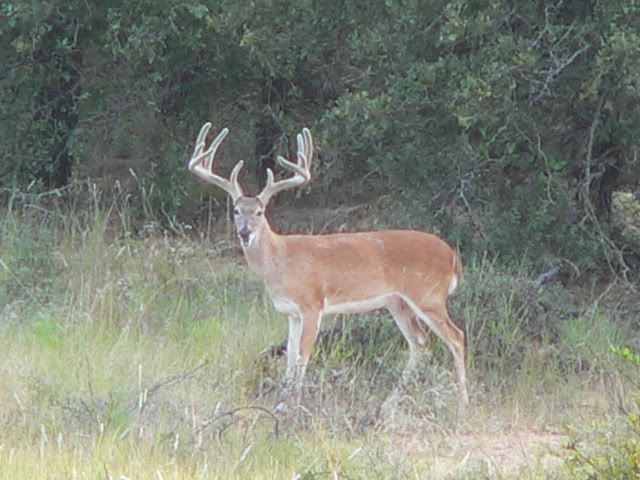
If you shoot a young deer because a neighbor will shoot it, you are that neighbor.
|
|
|
 Re: Deer Management
[Re: stxranchman]
#2649665
10/11/11 02:11 AM Re: Deer Management
[Re: stxranchman]
#2649665
10/11/11 02:11 AM
|
Joined: Sep 2010
Posts: 35,954
txshntr
 OP
OP
T-Rex Arms
|
OP

T-Rex Arms
Joined: Sep 2010
Posts: 35,954 |
Crab claws were just an example. What about 3.5 or 4.5 six and seven pointers? No brow tines? 4.5 year old eights that won't score 110"? I have never kept any deer that was 2.5 yrs or older that was less than 8 points unless I knew what the deer looked like the year before. I have never kept any buck missing any or both browtines. My minimums by age were 100 at 2.5 and 120 at 3.5 and mid 130's at 4.5 no matter how many main frame points they had. Just something I have done since early 90's that has worked for me. But this is only after I have reached a 1 to 1 ratio and at carrying capacity for the ranch. Great...so one says to cull and one says to control the population. If I put two and two together...wouldn't it make since to manage the herd by culling? Have you tried the same tactics in the hill country STX?
|
|
|
 Re: Deer Management
[Re: txshntr]
#2649675
10/11/11 02:13 AM Re: Deer Management
[Re: txshntr]
#2649675
10/11/11 02:13 AM
|
Joined: Sep 2010
Posts: 35,954
txshntr
 OP
OP
T-Rex Arms
|
OP

T-Rex Arms
Joined: Sep 2010
Posts: 35,954 |
Good looking deer Tye, but you haven't shown me a deer that we would cull. Granted, we are working with much smaller caliber of deer.
|
|
|
 Re: Deer Management
[Re: txshntr]
#2649693
10/11/11 02:17 AM Re: Deer Management
[Re: txshntr]
#2649693
10/11/11 02:17 AM
|
Joined: Apr 2007
Posts: 63,144
BOBO the Clown

kind of a big deal
|

kind of a big deal
Joined: Apr 2007
Posts: 63,144 |
Crab claws were just an example. What about 3.5 or 4.5 six and seven pointers? No brow tines? 4.5 year old eights that won't score 110"? I have never kept any deer that was 2.5 yrs or older that was less than 8 points unless I knew what the deer looked like the year before. I have never kept any buck missing any or both browtines. My minimums by age were 100 at 2.5 and 120 at 3.5 and mid 130's at 4.5 no matter how many main frame points they had. Just something I have done since early 90's that has worked for me. But this is only after I have reached a 1 to 1 ratio and at carrying capacity for the ranch.[b][/b] Great...so one says to cull and one says to control the population. If I put two and two together...wouldn't it make since to manage the herd by culling? Have you tried the same tactics in the hill country STX?
Last edited by BOBO the Clown; 10/11/11 02:19 AM.
Far better it is to dare mighty things, to win glorious triumphs, even though checkered by failure, than to take rank with those poor spirits who neither enjoy much nor suffer much, b/c they know not victory nor defeat"- #26 TR
|
|
|
 Re: Deer Management
[Re: stxranchman]
#2649707
10/11/11 02:19 AM Re: Deer Management
[Re: stxranchman]
#2649707
10/11/11 02:19 AM
|
Joined: Sep 2010
Posts: 35,954
txshntr
 OP
OP
T-Rex Arms
|
OP

T-Rex Arms
Joined: Sep 2010
Posts: 35,954 |
Have you done a survey every year? Do you do incidental counts? Keep harvest record on every deer taken? Do you have the past data to look at to see what the trends have been? Are buck/doe weights higher, the same or lower by age class? If you are not doing these things listed then you are just hunting at this point and not following a mangement plan or goal. Ever deer you shoot from the herd is culled from the herd be it a trophy or a doe. You can call it what you want but is the same result. It is a management descision and a number on the harvest data sheet. It is all very important data that you can show you what is going on with your herd.
I am also sure I know this ranch he is hunting on and what it has produced in the past as far as top end type deer. So genetics are not an issue if it is the same ranch. Lots of questions: Not surveys every year, but most of them. (this year work got in the way) We keep harvest record of every deer shot. We have kept the books on the ranch and have data from the last 12 years The weights have varied very little per age, but the population has dropped. The number of mature bucks is higher and with the exception of this year, we have had great fawn crops. What ranch do you think I am hunting?
|
|
|
 Re: Deer Management
[Re: highlonesome1]
#2649854
10/11/11 02:43 AM Re: Deer Management
[Re: highlonesome1]
#2649854
10/11/11 02:43 AM
|
Joined: Sep 2010
Posts: 35,954
txshntr
 OP
OP
T-Rex Arms
|
OP

T-Rex Arms
Joined: Sep 2010
Posts: 35,954 |
I can't imagine being able to eliminate the crab claws in that area. I hunted 100,000 acres NW of Angelo for years and there was a huge percentage of the bucks had 'em.
The ranch I hunted had never, ever, in it's entire history, been leased for hunting. We only got to hunt because my uncle was the foreman of the ranch. The deer herd was as close to pure as it could possibly be. I think that crab claws are just a trait of that area. I'm betting that every deer out there carries a gene for crab claws. Just my opinion. Txhunter I am familiar with your area and it sounds like you are doing just fine. Going off your posts pics etc, your deer are fine as any in the area. Crab claw is common on our place in Schleicher County as well. Keep in mind that trophy bucks are not always dominant bucks.
This year I would thin the herd by taking as many 4-5+ year old deer as you can. That is what I plan on doing. There is only so much browse for so many deer and with the drought possibly continuing through next year, this may be the best thing to do long term.
While I tell myself that alfalfa / protein makes all the difference, mother nature can provide way more than I can with just a couple good rains. If your deer are comparable to deer in their natural environment, you are doing the best you can. I agree LP. Never planned on eliminating them, just put a dent in them. We still have a couple a year, but used to take 10-12 of those alone. We tried the protien HighLonesome, but saw very little difference in antlers or body weight. My only guess is that it wasn't long enough. Overall, our ranch seems to produce good deer for the area, just always open to other recommendations. Anyone have any thoughts on a 3 to 4 year plan of only taking 8's and culls and leaving the 10's alone? We have tossed the idea around and it sounds fine in theory, but wasn't sure on effectiveness.
|
|
|
Moderated by bigbob_ftw, CCBIRDDOGMAN, Chickenman, Derek, DeRico, Duck_Hunter, kmon11, kry226, kwrhuntinglab, Payne, pertnear, sig226fan (Rguns.com), Superduty, TreeBass, txcornhusker
|

